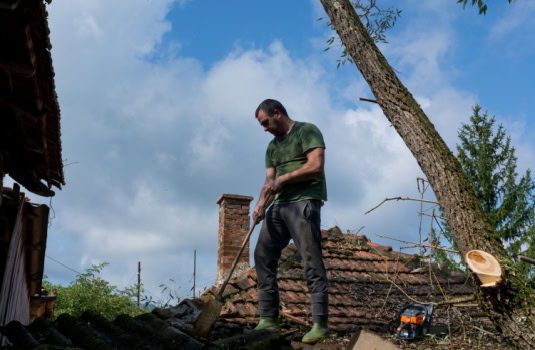
Have you ever looked at your homeowners insurance policy and wondered what exactly it all meant? It might just look like stacks of pages that are hard to understand. With all the different insurance terminology, it makes sense to avoid looking into the details. However, when an unexpected event happens and you’re facing financial losses, you’ll wish you knew what was in your policy.
Whether you’re a first-time homeowner or you’ve been a homeowner for many years, it’s important to understand the basics of homeowners insurance coverage. Read on to understand what should be included in a standard homeowners insurance policy.
Essential Coverages Every Policy Should Include
Every policy should include some basic protections that are considered essential to the homeowner. Whenever a disaster strikes, you want to be sure your home’s physical structure and personal belongings are covered. Also, if you must move out of your home temporarily, do you have coverage? For example, what if one of Georgia’s deadly tornadoes strikes your home? Fortunately, a good policy will ensure you’re not left out in the cold.
You also have to think about what could happen if somebody gets injured on your property. You don’t want a lawsuit on your hands. Liability coverage is another important aspect of your home insurance policy.
If you review a standard homeowners policy, you will notice it protects you from these basic things.
Dwelling Coverage (Coverage A)
Whether your home is damaged in a storm, fire, or some other type of unexpected emergency, your dwelling coverage is an essential part of your policy. Without this, your losses would be tremendous. Dwelling protection provides the funds to help rebuild and repair your home in times of such events.
Whether your roof gets blown off in a storm or a fire damages the inside of the house, you can count on dwelling coverage to help you rebuild or repair the damage. Many times, exterior buildings, such as sheds and outbuildings, are damaged.
You may be wondering how much insurance you will need for this portion of your policy. You want to ensure that you have enough to cover all costs. Most providers recommend following the home insurance 80% rule. This rule consists of having enough insurance to equal at least 80% of the full replacement cost of the dwelling.
Certain natural disasters, such as floods, are not covered under a standard policy. Check with your provider to see what events are covered.
Personal Property Protection (Coverage C)
Personal property insurance covers the items inside your home, like furniture, electronics, sports equipment, clothes, etc. Be sure you have all of your items documented by creating a home inventory list. The coverage for this is based on how much you have for the structure. Review this with your insurance carrier to make sure you have enough. For example, if you have many expensive personal belongings, you may want more protection.
Liability Protection (Coverage E)
You’ve surely heard stories about somebody getting injured while out and then suing the person or business because of their injuries. Your liability protection covers you if this happens. Talk to your agent about what family liability protection includes.
Loss of Use Coverage (Coverage D)
Sometimes, a disaster may cause such severe damage to your dwelling that you must move out while it’s being repaired or rebuilt. Loss of use coverage will provide living arrangements for you while the work is completed.

Navigating Optional Add-Ons
It always pays to double-check what optional add-ons you might need for your situation.
Additional Structure Coverage (Coverage B)
Your standard homeowners policy will cover other structures detached from your home. However, the coverage may not be adequate if you have many buildings or other structures on your property. You can add this to your current policy to make sure you don’t have to pay out of pocket.
Water Backup and Sump Discharge
Your standard policy typically excludes loss due to water damage resulting from drain backups and sump pump or sewer overflows. Adding this option delivers financial protection from these issues.
Personal Injury Endorsement
Not all injuries are physical. What if there’s a situation involving slander against your reputation? There may be other personal injuries that involve wrongful eviction, invasion of privacy, etc. In these instances, your personal injury endorsement will cover attorneys and other legal costs so that you do not suffer financial loss.
The Perils You’re Protected Against
When unexpected events cause damage to your dwelling, personal belongings, or property, they are referred to as perils. But not every peril is covered. Your homeowners policy will outline the specific perils covered. Listed below are the most common ones.
Commonly Covered Perils
- Windstorms
- Hail
- Fire
- Smoke
- Lightning
- Snow or ice damage
- Theft
- Vandalism
- Explosions
- Damage from a power surge
- Freezing of certain household systems
- Water overflow from household systems like plumbing, appliances, and air conditioning
- Volcanic eruptions
- Falling objects like a tree branch
- Riots
- Damage from aircraft or vehicles
What’s Typically Excluded?
A standard policy does not cover every unfortunate incident. There are some things that are not covered by your Georgia policy. The following may need its own coverage:
- Floods that originate from external sources
- Power failure
- Earthquakes, sinkholes, and landslides
- Drain and sewer backups
- Infestations by birds, vermin, fungus, or mold
- Wear and tear
- Neglect
- Nuclear hazard
- Government action, including war
Tips on How to Choose the Right Home Insurance Policy
Selecting the right policy is the first step in ensuring you are covered in times of need. An agent can help you determine what specific additions you may need and how much coverage will be necessary.
Estimating How Much Coverage You Need
You can get a pretty good idea of how much coverage you’ll need by the amount required to replace your house, how many outbuildings you have, and the estimated cost to replace your personal belongings. As stated above, the 80% rule applies to the amount of coverage you should purchase.
Ways to Reduce Your Premiums
You can reduce the cost of your annual premium by avoiding mistakes that make you pay too much and by implementing some or all of the following:
- Increase your deductible
- Invest in a good security system
- Compare the cost of different insurance companies
- Ask your insurer about home insurance discounts you might be missing